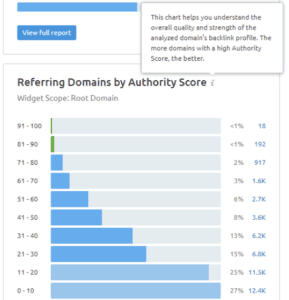If you’re still unsure about where to start, we can help.
With our free tips and guidance, you can build a better digital marketing setup. But if you don’t have the time or resources to manage it all on your own, we can support you. Get in touch to find out how.
‘Off-page SEO’ refers to all the actions you take outside your website to drive more visitors and engagement – called ‘link building’. In other words, it’s the strategies you put in place to link people back to your website or priority pages.
Although this can be demanding, its rewards are well worth the effort. As people continue to reference and visit your website from other websites and platforms, search engines start to rate your website higher.
This, in turn, leads to growth in your website domain authority (DA), brand recognition, and ranking on search engine result pages (SERPs). So, how do you tackle this side of your SEO efforts? Here are some key steps that will guide you through the process.

1. Know your backlink profile
The first thing you want to do is run a backlink analysis on your website to know where you stand in backlinking. Ask yourself:
– Do other websites or platforms reference your website with a link (backlinks)?
– How reputable are these websites (domain authority)?
– What texts do they use to drive their users’ attention to your page (anchor text)?
– Which pages are getting the most links?
– And what type of links are they (dofollow or nofollow)?
Knowing the answer to these questions will allow you to determine the areas that need improvement. Tools that will help you run a backlink check include:
- Google Search Console,
- Seobility,
- SEO spyglass,
- and SEMrush.
2. Check your competition backlink profile
Now that you have this information, it’s time to understand where your competitors stand (both direct competitors and SERP competitors), and what they’re doing better.
Using a backlink checker like the ones listed above (excluding Google Search Console), type in your competitor’s domain and click ‘Analyse’.


Look out for their:
- Domain authority.
- Number of backlinks.
- The domains referencing them.
- The trust flow of referencing domain (their domain authority).
- Broken links (links that no longer work).
These focus areas will let you know the ideal competitors to learn from, what they’re doing right, and what opportunities you can explore.


Support Services
Explore our services to see how we can support you.
We work with clients of all sizes, ambitions, and expectations, and with budgets that start from as little as £150pm to over £1.5m each year. Explore our simple-to-understand packages that take the pressure off, so that you can focus on what you do best.
3. Determines what works for you
There are several off-page strategies you can focus on to boost your traffic, page rank, and website authority:
- Broken links.
- Cold outreach.
- Local citation.
- Paid advertising.
- Social networking.
- Guest blogging.
Studying your competitors’ backlink profiles and your business strengths (time, money, workforce etc.) allows you to find your ideal strategy.
4. Make sure your website is ready
Be sure to run an SEO audit on your site before implementing your off-page SEO plans.
It’s essential to check your website’s on-page and technical SEO compliance before you start link building. Because after investing time and money, the last thing you want to see is zero engagement, higher bounce rates, and zero visits from your backlink visitors. These are very likely to happen if:
- Your page links are broken or misspelt.
- Your page load speed is slow.
- Your page design lacks inspiration.
- Your content quality and strategy are poor.
Running periodic site audits helps you find errors and shortcomings like these, which could be easily missed, but which will cost your business dearly.
5. Internal linking
Finally, you want your off-page visitors to stick around on your website as long as possible. A way to make that happen is through internal linking.
Internal linking is the placement of links on a page directing readers to other internal pages on your website. This strategy can boost the performance of your linked pages on the keyword they’re targeting for SERP.
As such, SEO experts often recommend that a page has at least two to three internal links. The more internal links a page naturally requires, the higher search engines like Google view it as a priority page compared to other pages on a site.
To boost the SEO impact of internal linking, we advise that your internal links lead a visitor down a path of continual discovery for each side topic.
For example:
A visitor to your site clicks on an internal link with the anchor text “off-page SEO.” There they discover another link with the anchor text “properly analyse backlinks.” This continues until there are no other important side topics to address.
Getting your Off-page SEO right is critical to boosting your website’s performance. Just as it’s critical to get your On-page SEO right. To find out how, check out our blog: SEO 101 | What’s on-page SEO, and how to set it up?

Get a free website health-check.
Find out if your website is depriving you of visitors. Request our free website health-check to identify common issues with speed, user experience, and performance. We’ll deliver this in a clear report along with some basic recommendations and quick fixes.
Learn more about health-checks
Frequently asked questions
-
As the name suggests, ‘On-page SEO’ is the improvement you make to your web page to rank higher on the SERP and get more visits and engagements. We’ve explained it here in more detail.
-
As you run your online business, it’s essential to carry out website auditing periodically. This will guarantee you get the best results from your campaigns and help you achieve organic growth. Here are some helpful steps to keep in mind.
-
Backlinks and internal links (inner links) are integral to your SEO success. Both improve your page’s traffic and ranking on the SERP. See how and why here.
-
Many successful businesses outrank yours in search results and conversion. To meet and exceed them, you need to study what they’re doing better and how you can improve on that. Here is how to go about it.
Start a Conversation
Request a call-back to see how we can support your digital growth.














